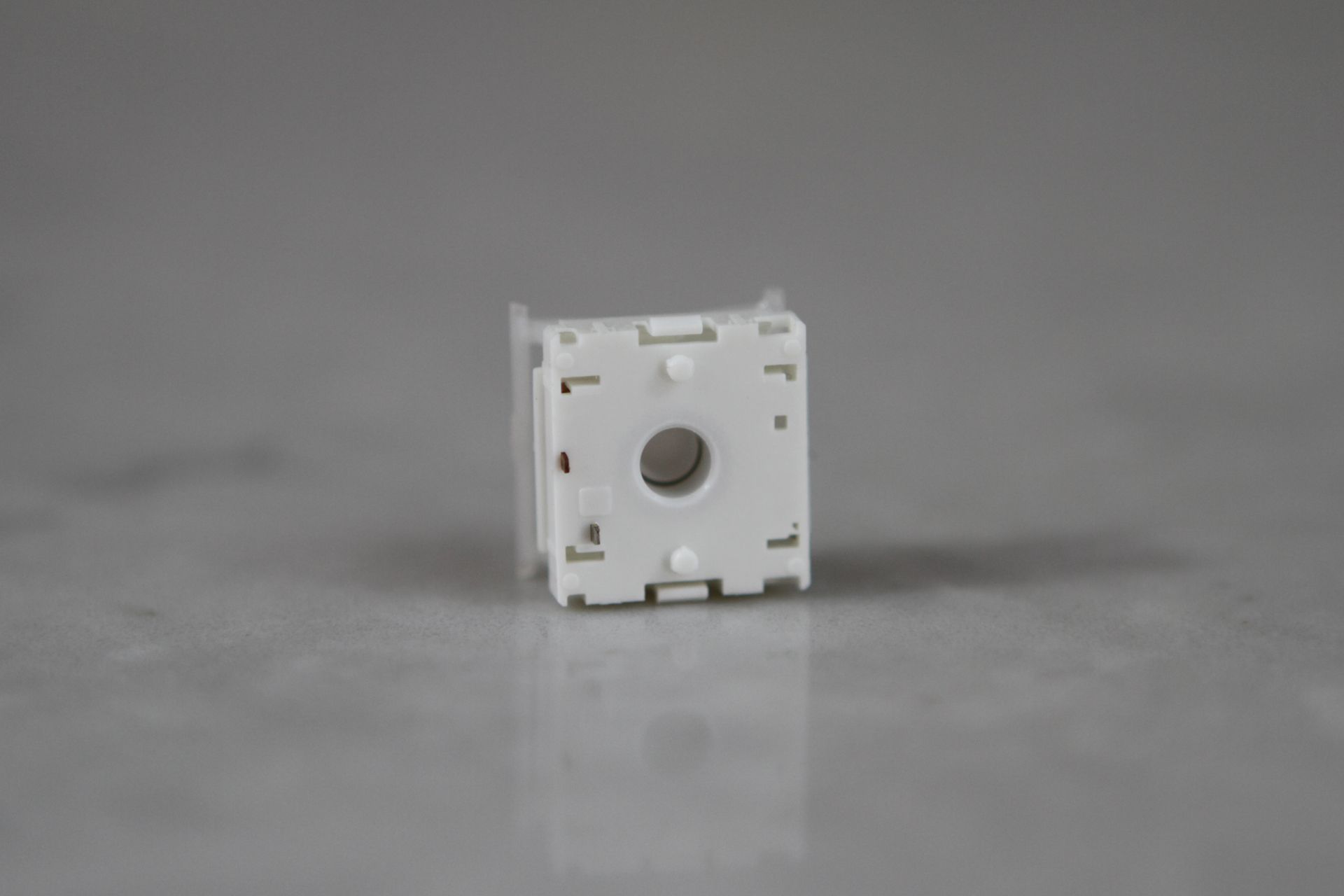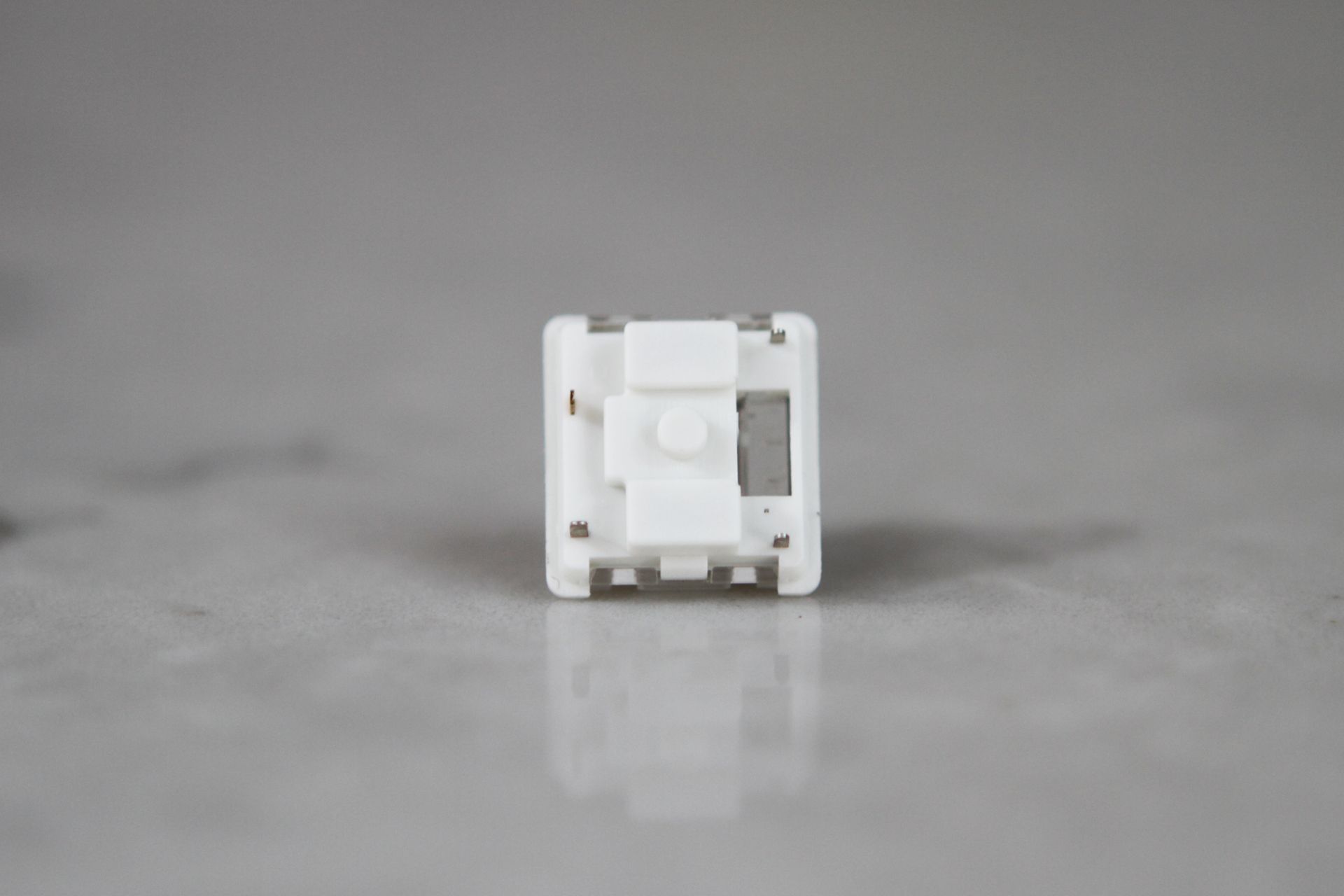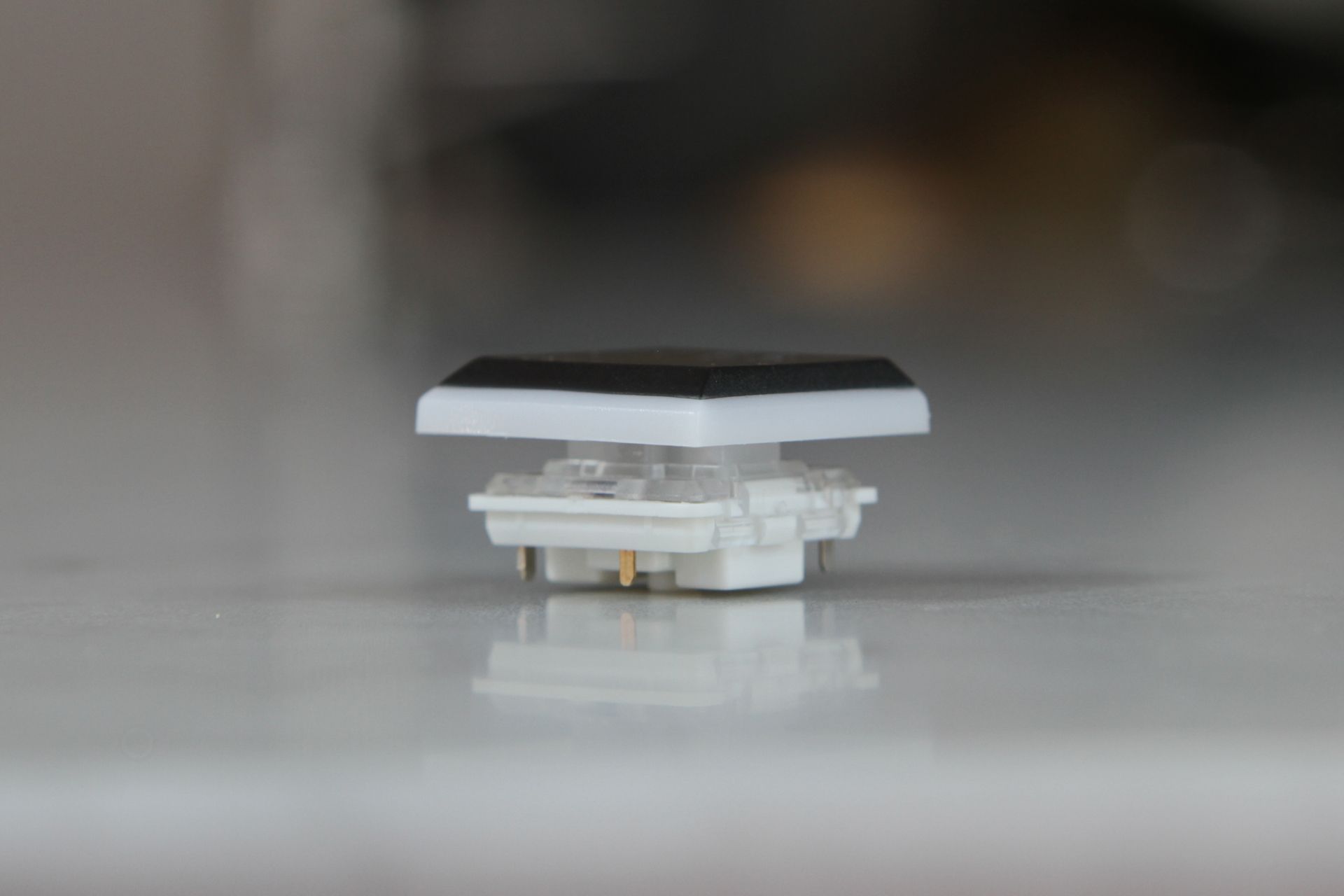Teardown: Kailh Low-Profile Switches
There’s a proliferation of low-profile mechanical keyboard switches, and although multiple switch makers are working on them, ground zero is Kaihua. We got our hands on samples of some of the new switches and tore them apart to see how they’re constructed.
So Many Switches
Back at Computex 2016, we got our first glimpse of Kaihua’s low-profile PG1350 switches. At Computex 2017, the company showed off three new low-profile designs: the PG1232, which is strikingly similar to the PG1350 line, and two scissor switch-type variations, the PG1425 and PG1442.
That’s a lot of low-profile switches, and bear in mind that those are not linear/tactile/clicky variations. Those are distinct designs, each of which has (or could have) linear/tactile/clicky versions. It seems that Kaihua is creating several designs to see which ones work best and will stick with users when deployed on shipping keyboards.
For example, the PG1232 and PG1350 are more or less iterations of one another, so it’s possible that Kaihua is just feeling out the market with them.
Meanwhile, although the PG1425 and PG1442 are similar in some ways--mainly the presence of a scissor arm--they’re quite different in others. The fact that we were unable to obtain samples of the PG1445 switches tells us that, internally at Kaihua at least, the PG1442 is the frontrunner.
We tore down the PG1232 and PG1442 switches and compared them to PG1350 and standard full-size Kailh Blue switches.




The PG1442: Light Pipe And Scissor Design
Among all the mechanical switch designs out there, the PG1442 is one of the most fascinating.
Get Tom's Hardware's best news and in-depth reviews, straight to your inbox.
First of all, it employs scissor arms, like a laptop or chiclet-style keyboard. However, whereas most scissor designs are just rubber dome switches that use the scissor arms for stability, these PG1442 switches are actually mechanical, even though they also use the scissor arms for stabilizing the keycap and pushing down the slider.
The other most notable aspect of the PG1442, and frankly possibly the primary reason Kaihua appears to favor it, is its light pipe design. The vast majority of mechanical switches with backlighting capabilities have a tiny slot somewhere in the switch housing, usually on the “north” part, to accommodate an LED. This is true even for “RGB” switches that have clear housings designed to let the backlighting explode underneath the keycap.
The problem is that the LEDs are therefore always off center. This can create uneven lighting behind keycap legends and also on the surface of a keyboard. It’s also a “messy” light design. For example, with clear switch housings, the light bleeds all over the place (which is desirable in many situations) but if you want a more controlled backlighting design and want to ensure even lighting under keycaps and legends, nothing beats a light pipe design.
Simply put, the LED is placed under the center of the switch, the light is kept from bleeding out by the light pipe, ensuring controlled lighting, even glow under legends, and optimal brightness. (Logitech employs this to splendid effect with its Romer-G switches.) One caveat with the PG1442 is that so many pieces of the switch are translucent that you’re going to see a certain amount of light bleed in this particular design.
In the case of the PG1442, the scissor arms are absolutely necessary. If you pop off the chiclet-style cap that Kaihua wants to deploy with them, you can see and feel how incredibly wobbly the actual switch stem is. It’s downright loosey-goosey.











When you put the cap on, it locks into and rests on the scissor arms, which provides fairly strong stability. Then, when you press down, the sides of the scissor arms press down on four nubs (two on each side) of the slider. In that way, it creates some additional stability for the slider itself. The keycap, then, stabilizes the scissor arms, and the scissor arms in turn stabilize the slider.
Having just a few samples on hand, it’s difficult to draw significant conclusions about how the switches seem to perform, but we found the PG1442 switches to be somewhat “sticky” on the rebound. This is because of the scissor design; the press feels just fine, but towards the end of rebound, there’s an extra little hitch before the scissor arms fully reset. The rub, as it were, seems to be where the scissor arms mount inside the keycap.
To be clear, some of our samples didn’t seem to suffer from this issue, but a few did, in spades. Kaihua may need to revisit some small aspects of the arm design--perhaps just the chiclet keycaps, which for all we know were an afterthought in the switches’ construction--or use a different spring. The spring in these switches is short and wide compared to others in the Kailh family, which is perhaps obvious but no less interesting. In any case, the problem may go away with a heavier spring pushing the scissor arms back into place.
The PG1442 switches have a thin plastic bottom switch housing. A rectangular slider with a stem underneath nestles into that housing, and of course the spring keeps the two in line. On one side of the switch housing is a hair-thin metal arm that’s coiled on one end; on the other side is a tiny metal contact point with a separate copper piece inserted into the housing. The mechanisms on both sides are covered by a translucent piece of plastic.
The rectangular part of the stem assembly has two little nubs that flick the copper contact point and metal arm when you press down. That’s what gives you the click.
PG1232: Like The PG1350, But Smaller
Although it’s certainly important to compare the PG1232 switches to the PG1442, it’s perhaps more informative to put the PG1232 next to its bigger brother, the PG1350.





A quick look shows that the former is slightly thinner than the latter--even lower-profile--and the underside protrusion (that slots into a PCB) is a bit shorter as well. The actual slider assemblies of the two switches are nearly identical in size and shape, but there’s one key difference: Whereas the underside of the PG1350 is solid, the underside of the PG1232 has cutouts. Thus, when you press the PG1232, it nestles down further into the switch housing. It’s a clever modification to the original stem design, to be sure.
The edges of the PG1232 also measure a bit smaller than the PG1350--but just a bit. The former measures 15 x 14mm, whereas the latter is 15 x 15mm.
Inside, the construction is all but identical. Although we have only Brown (tactile) PG1350 switches and White (clicky) PG1232 switches on hand, which effectively gives us an apple to oranges comparison, we externally confirmed how the construction of the White (clicky) PG1350 differs from the Brown. Thus, we know that the White (clicky) versions of both the PG1350 and PG1232 share the same slider, clear top housing, and clicky metal bar with the coil on the end. They have what appears to be identical stable contact points, although the dynamic metal contact points are slightly different sizes. They also have different springs and different pinouts on the bottom, and whereas the PG1232 has a little wraparound stabilizer bar, like the Brown PG1350, the White PG1350 does not.








The biggest difference between the two is the actuation point and travel. With an actuation point of 1.5mm and overall travel of 3mm, the PG1350 is certainly on the short side of what you’ll ever see in a desktop switch (most standard mechanical have 4mm travel), but the PG1232 is even shallower. It offers 1.2mm actuation and just 2.4mm total travel. For context, many standard mechanical switches have 2mm pretravel; the PG1232 has 2.4mm travel total.
Interestingly enough, both switches require 50gf at the actuation point and 60gf at the pressure point.
What’s What
Considering the above teardowns and what we know (and presume) about Kaihua’s low-profile switch efforts, we have some preliminary conclusions.
First, it’s a little odd that Kaihua would develop both the PG1350 and PG1232, considering how similar they are. It would perhaps make more sense to have just the standard (“full size”) desktop switch plus the PG1232 for low-profile desktop keyboards and laptops. However, Kaihua sees the PG1350 as a ‘tweener option. Whereas the PG1232 was designed explicitly for laptops, the PG1350 is for either desktop keyboards or laptops. (The PG1232 could be used in a desktop keyboard, but the company thinks users won’t like the extra-short travel on such a peripheral.)
We wouldn’t be surprised if Kaihua is just waiting to see how the market reacts to both switches and is planning to focus on whichever one seems to gain the most traction, and where. Of course, both could end up in their own respective niches, too.
The PG1232 and PG1442 are both designed for laptops, but they’re significantly different designs. Obviously, there’s the scissor design on the latter, and they have incompatible keycaps. Further, the PG1232 has a spot for an LED at the top of the housing, whereas the PG1442 has the centered light pipe design. They also have different springs and completely different sliders. They do have the same click mechanism (via the thin metal bar with the coil on the end) and similar contact point designs, though.
They’ll almost certainly be deployed in different types of laptops, too. Gaming notebooks, where users will demand something that feels much more like their desktop mechanical switches, will be the vehicle for the PG1232, whereas the slimmer PG1442 will be more likely to end up on more mainstream notebooks for OEMs that want to offer a superior typing experience to the current standard of scissor switches. As we noted, though, Kaihua may need to polish up the PG1442 a little more to ensure a smoother rebound.
And let us not forget about the PG1425 switch--another scissor design, intended for notebooks, that employs a horizontal click action rather than a vertical one. Kaihua doesn’t have samples of this one yet because its engineers are still tweaking it. Thus, although we’ve seen these in the wild (at Computex 2017), the version we saw there isn’t the final one.









To recap: Kaihua has no fewer than four low-profile mechanical switches in the works. It’s unclear if the PG1425 will ever become a Real Thing; its scissor sibling, the PG1442, is not yet in production but is “finished,” although there are no promises that it will end up in shipping products. By contrast, we fully expect to see the PG1232 switches appear on gaming notebooks soon enough, and possibly desktop keyboards, too. Meanwhile, although the PG1350 could land on notebooks, it has already begun to proliferate on shipping desktop keyboards.
| Kaihua Low-Profile Switches | PG1350 (Choc) | PG1232 (Mini Choc) | PG1442 | PG1425 |
|---|---|---|---|---|
| Type | Linear, tactile, clicky | Clicky | Clicky | Clicky, tactile |
| Actuation Point | 1.5mm (+/-0.5mm) | 1.2mm (+/-0.5mm) | 1.4mm (+/-0.3mm) | -- |
| Actuation Force | 50gf | 50gf | 50gf (+/-10gf) | -- |
| Pressure Point Force | 60gf | 60gf | 55gf | -- |
| Action | Standard | Standard | Scissor (vertical slider) | Scissor (horizontal slider) |
| LED Location | Top of switch housing | Top of switch housing | Center | Top of switch housing |
| Total Travel | 3mm (+/-0.5mm) | 2.4mm (+/-0.5mm) | 2.7(+/-0.2mm) | -- |
Seth Colaner previously served as News Director at Tom's Hardware. He covered technology news, focusing on keyboards, virtual reality, and wearables.
-
derekullo I can't stand clicky switches.Reply
You can always tell when someone on mumble has a clicky keyboard ...
